Heartland Film Festival: Seeing Is Believing: Women Direct

For tickets and showtimes, please click here.
Part history, part lament, part passionate call to action, “Seeing is Believing: Women Direct” is filmmaker Cady McClain’s documentary about the importance of having female directors behind the camera. It’s an intellectually and emotionally effective outcry against an industry where, even today, more than 90 percent of Hollywood films are directed by men.
McClain takes turns interviewing subjects and appearing as one herself. She grew up as a child actress and then worked on soap operas where, she says, “I was not often asked what I thought.”
This film, she says, is her effort at a “hunt for the female voice.”
Dozens of women filmmakers appear to offer their perspective. They talk about how they broke into the business, how people walk into a meeting assuming somebody else is a director, how other women lifted them up and gave them encouragement to press on. Of course, they attempt to pass the torch themselves.
Some of the subjects are legends, like Lee Grant and Betty Thomas, or well-known contemporary directors like Kimberly Pierce (“Boys Don’t Cry”). Others are young, hungry women with a burning desire to create motion pictures, like Naima Ramos-Chapman (who also provides the soundtrack for this film) and America Young, whose no-budget filmmaking projects are practically guerilla operations.
Four directors act as the cornerstones: Ramos-Chapman; Leslie Linka Glatter, a successful television producer/director (“Homeland”); Brit Sarah Gavron (“Suffragette”); and Li Lu, a young emigre from China (“There Is a New World Somewhere”).
Glatter talks about how she was given opportunities by Steven Spielberg, who became her mentor. Lu says she’s never had a real mentor and would desperately love one. In the meantime, she’s focused on simply getting into the meetings where movie deals are made.
There is much discussion of the imposter syndrome, where even very accomplished artists feel like their voice won’t be listened to because it is that of a woman. Some of the filmmakers say they were inspired by their mothers, like Gavron, whose mom was a politician. Meanwhile, Ramos-Chapman says her mother has been indifferent to her journey as a director.
Most what comes through is that these women have a shining love of cinema, and a desire to tell stories. When half of the human population is nearly shut out of the creation of film, it leads to a sclerotic effect in which audiences only see the same stories, the same heroes, the same expectations.
In one recurring bit, McClain interviews random people and asks them to name their favorite female director… or any woman filmmaker. Most can’t, including the female subjects.
When victims of a lack of diversity talk about their situations, one recurring theme in their words is the feeling of being invisible. This documentary is one small step in shining the spotlight somewhere else.



